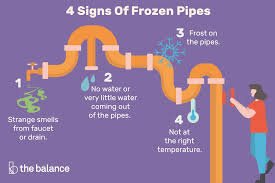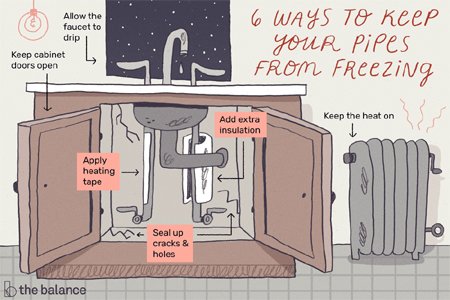FROZEN PIPES
Thawing and Prevention
Frozen pipes not only mean the inconvenient lack of water, they also can burst, causing an expensive repair problem.
Homeowners are often understandably frantic to get water pipes running again. But thawing the pipes improperly can lead to more problems.

THAWING FROZEN PIPES
If there are pipes located against an outside wall, in an uninsulated area of the basement, crawl space or attic, they need your immediate attention. If you have an outside faucet, this can also be a problem area.
CAUTION: Never use a device with a flame to thaw out pipes! A little heat on the right pipe could get that water flowing. But a flame on the pipe is a very bad idea!
According to fire experts, flames under the house, even when directed at pipes, are a common cause of fire. The open flame from a heater, especially a propane salamander, can instantly ignite insulation or flooring materials under a house.
Even worse, pipes can heat up dramatically from flaming devices allowing heat to travel along the piping systems inside walls. This heat can ignite wall materials. The fire can smolder for hours before being discovered or bursting into flame.
Excessive heat on metal piping can also cause water to boil, resulting in a burst pipe.
If you do not know where the pipes are frozen, do the following:
- It is a good idea to turn up the heat in the house while you are looking for the frozen pipe. The affected pipe may be inside a wall or another difficult-to-access location; if this is the case, the time spent trying to track it down could be just enough for the pipe to reach the bursting point. Having additional heat circulating through the home may buy some time.
- First open the faucets and then apply heat with a hair dryer or electric heating pad. Keep the faucets open. As you treat the frozen pipe and the frozen area begins to melt, water will begin to flow through the frozen area. Running water through the pipe will help melt ice in the pipe. When using hair dryers, heat lamps or heaters on a frozen pipe close to a wall, try sliding a cookie sheet or aluminum foil between the pipe and wall to reflect as much heat as possible toward the pipe.
- If no hair dryer or electric heating pad is available, you can soak towels in hot water and wrap them around the pipes. Keep heat on the pipes until full water is restored.
- Know where your main water supply is. If a frozen pipe does burst, immediately shut off water to the house. If the pipe is in an accessible location, you can then thaw what remains in the pipe, collecting what melts. While the damage to the pipe will have already been done at that point, this will save you from further - and more severe - water damage. You can then decide whether you want to attempt a temporary repair or call a licensed plumber immediately.
PREPARE AHEAD OF
VERY COLD TEMPERATURES
If you know your pipes are prone to freezing here are some simple steps to take ahead of very cold weather:
- Give yourself a supply of water. You can partially fill a bathtub with water when very cold temperatures are predicted. This can provide water for pets, cleaning, or bathing. It will also give you some breathing room so you can take your time unfreezing pipes.
- Keep faucets open to a drip. This will help prevent pipes from freezing. Although this can put a strain on water pump systems, it is usually better than broken pipe disasters.
- Close garage doors, especially if there are pipes along the garage walls.
- Open your cabinet doors in the kitchen and bathroom to allow warm room air to circulate.
- Don’t turn down the house temperature during very cold nights. Never set the thermostat to less than 55 degrees when the weather will be below zero.
LONG-TERM PROTECTION
FROM FROZEN PIPES
Here are some hints:
- One of the best ways to prevent frozen pipes is with heat tape or heat cable. These low-heat products usually can be plugged in at the beginning of the season and left until Spring. This is especially good for pipes that are run along the outside of walls. Note: Do not double down on heat cable because crossing the cable back over itself can lead to overheating and damage, especially with non-automatic cable and plastic pipes. Always follow manufacturer instructions and inspect heat cables annually.
- Be sure to unhook outdoor hoses and close valves supplying outdoor faucets.
- Insulation in attics, basements, and crawl spaces will help prevent frozen pipes as well.
- If the house is going to go unused for some time, nontoxic antifreeze (the same as used in RVs) can be poured into traps to prevent them from freezing.
- If the problem with frozen pipes is persistent every winter season, consider moving exposed piping. Although this is a major project, it should prevent future problems.
"The Cleanest Clean You've Ever Seen."
by
ABC Oriental Rug & Carpet Cleaning Co.
130 Cecil Malone Drive Ithaca, NY 14850
607-272-1566








